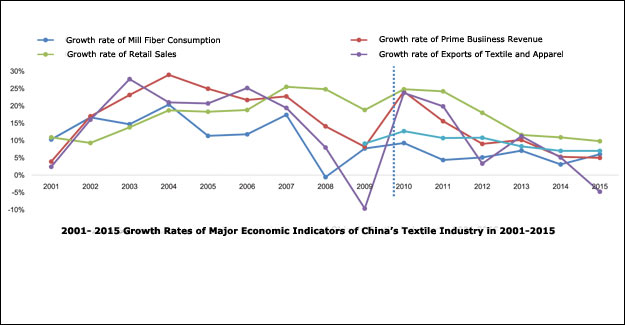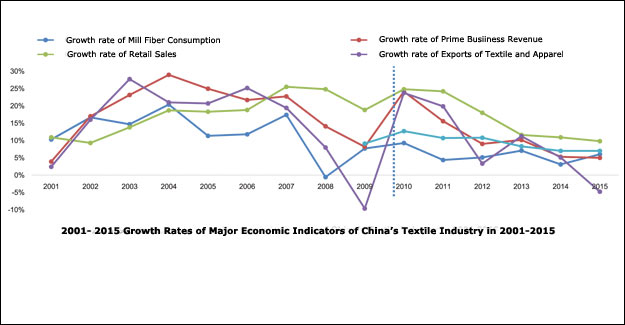
China Will Invest US$ 8 Billion In New Textile Capacities In Xinjiang Region
1. China is adding new capacities in cotton and polyester.
2. China is working towards sustainable development of its textile industry.
3. China is developing Xinjiang region as its textile manufacturing hub.
4. China is trying to change the trade balance with its ambitious Silk Road and Maritime Route projects.
5. Top international retailers are not leaving China in a hurry.
6. China will remain a textile giant for many years on.
These were a few clear indications during the Urumqi Forum on Sustainable Development Of Textile Industry Under Paris Climate Agreement.
The Chinese government is planning Xinjiang as the hotbed of textile and apparel manufacturing. It is expected that China's northwest region will become the country's largest textile production base by 2030, with a clear focus on sustainable development and intelligent manufacturing.
China is planning investments to the tune of 56.24 billion yuan (US$ 8.43 billion) in setting up Korla economic and technological development zone in Xinjiang Uygur autonomous region, which was founded in 2000. The zone was named a new industrialization textile industry demonstration base by the Chinese Ministry of Industry and Information Technology in 2013. Over 95% of these investments are towards the development of the textile and clothing manufacturing capacity in the area.
The government's blueprint is to build a textile and garment city, to transform the local cotton resource advantages into economic advantages. Xinjiang is a large region of cotton production. Bayingolin Mongol Autonomous Prefecture (after Bazhou) is one of the three largest cotton producing areas in Xinjiang. Bazhou is an important textile industry base in Xinjiang.
Here are some of the government's investment plans for Xinjiang:
a. The Korla Economic and Technical Development Zone is being set up with the objective of green, clean, intelligent manufacturing
b. The zone will have a 50,000 ton polyurethane fibre (spandex) project, with an investment of 3 billion yuan
c. 1 million meters of digital printing project, with an investment of 50 million yuan
d. 200 shuttleless loom project with an investment of 10 billion yuan
e. 1200 circular knitting machine project to produce 85000 tonnes of high-grade fabric with an investment of 500 million yuan. Expected revenue will be 3 billion yuan, with a payback period of 4-5 years.
f. 3 printing and processing projects - a 60000 ton knitted fabric dyeing and post-processing plant; a 20000 tonne Tong yarn dyeing and post processing project; and a 800 million meters fabric dyeing and post-processing plant. This will be at an investment of 1.75 billion yuan. This will include million sets of bedding every year, with an annual value of 1.35 billion; 7.5 million meters of curtain fabric, valued at 150 million yuan. Annual sales income is expected to be 147.75 million yuan. The products will be mainly for the Xinjiang and the international markets in Middle and West Asia.
g. 27000 tons of nonwoven project with an investment of 900 million yuan. The applications will be mainly in medical, agricultural and construction.
h. 250 million yuan project of processing 2 million square meters of tufted jacquard and handmade carpets, annually
i. A 1.5 billion yuan project to produce 150 million pieces of woven apparel for premium brands. This will include 50 million pieces of casualwear for leading brands, 30 million branded shirts, 20 million pieces of national costumes. It also includes 40 million pieces of branded womenswear and 10 million pieces of children's wear, again for premium brands.
j. 800 million yuan project for manufacturing 50 million pieces of premium brand knitwear, including 40 million pieces of knitted garments (Tshirts, underwear, bras), and 10 million pieces of high-grade sweater, annually.
k. 620 million yuan project to manufacture 100000 tons of PET annually
l. 21.8 billion yuan project to manufacture 1 million tonnes of ethylene propylene project annually.
m. 380 million yuan project to manufacture 100000 tonnes of urea formaldehyde resins
n. 4 billion yuan project to manufacture 200000 tonnes of caprolactum per annum
o. Annual output of 100000 tonnes of DMC with an investment of 6 billion yuan
p. Setting up a logistics centre of household textile products with an investment of 150 million yuan.
q. A logistics distribution project with an investment of 200 million yuan will include among others a distribution centre and regional freight loading and warehousing logistics base.
r. 200-500 million yuan project to produce cotton textile equipment and accessories
s. 150 million yuan investment to construct clothing industrial park and public service information which will include training facilities, public information technology platform, promotion of industry technical standards.
While these are ambitious plans, there is skeptism about the success of the project due to a short supply of water, power, labour, in the region.
Jinsheng Group sets up capacities in Xinjiang
However, China's largest textile company, Jinsheng Group doesn't think so. The company has set up a large cotton yarn manufacturing base in Korla. How big you ask? 1.08 million spindle facility built over the last 16 months. With a commitment to go green, the company uses Better Cotton. "We are developing and using processes for dyeing textiles with natural plants and herbs. Recycling is another area that we are investing in. Today, globally, around 15-20% of textiles are recycled. In China, it is less than 3%. Jinsheng wants to change this. Our focus is on intelligent + high end + energy efficient manufacturing," informed Pan Xueping, Chairman, Jinsheng Group.
The government is building industrial water supply network to the zone, with charges ranging from 1.54-2.88 yuan/cubic meters. The government has promised that water charges will go down significantly upon completion of the water supply network. Other essential utilities in the development process include power, gas, sewage treatment.
With these developments, it is expected that over the next 15 years, China, Uzbekistan, Pakistan and India, between themselves will have around 100 million spindles. Incidentally, Jinsheng Group is investing in Uzbekistan too. In the first phase, the company will set up spinning capacity, and will forward integrate in the next phase.
China currently accounts for 43% of the global cotton spinning capacity. It accounts for over 54% of global fibre consumption. And 38.53% of global textile and apparel exports.
In the first seven months of 2016, China’s investments in the textile and apparel industry amounted to 672.09 billion yuan, up 7.29% year on year. In the same period, textile enterprises' prime operating profits totaled 6.96 trillion yuan, up 4.54% year on year.
All the talk about China vacating a space in the textile and apparel sector and affording more space to other players does not seem to be quite true. China remains the largest supplier of textiles and apparel to the US market, accounting for a share of 38.92% in 2015, a slight improvement from 38.74% in 2014. Vietnam's share remains at 9.26% (9.27%) in 2015, India is at 6.25% (6.25%), Bangladesh 4.66% (4.65%), Indonesia 4.71% (4.71%), Pakistan 2.71% (2.85%), Turkey 1.12% (1.08%).
In the Japanese market too, Chinese suppliers dominate with a share of as much as 64.53% in 2015, which has come down slightly from 67.39% in 2014. Vietnam's share is 9.51% (8.11%), Indonesia 4% (3.62%), Italy 2.79% (2.87%), Thailand 2.51% (2.39%), India 1.19% (1.20%), Bangladesh 2.27% (1.75%), Pakistan 0.33% (0.31%).
Current sustainability parameters in the Chinese textile industry
In the first half of 2016, water consumption of textile companies fell 2.9% year on year, 1.1 percentage points higher than that of all industries. China's textile industry is among the top 4 industries in terms of wastewater discharge, COD emissions and nitrogen ammonia emission.
The industry, in the last five years, has invested in upgrading its facilities to become more efficient. From 2011-15, the textile industry invested 610 billion yuan in installing new textile machinery and eliminated high energy-consuming, high pollution and low-efficiency printing and dyeing capacity, thus eliminating outdated capacity of 11.7 billion meters of fabric, and 1.3 million tonnes of chemical fibre.
In January-July 2016, printing and dyeing enterprises above designated size produced 30.26 billion metres of printed and dyed fabrics, upto 0.79% year-on-year, earned prime operating revenue of 219.19 billion, up 2.05% and total profits of 10.37 billion yuan, up 10.63% over the same period of last year.
The technology upgradation resulted in substantial reduction in energy consumption per unit of product. Total energy consumption of the three major textile sectors began to drop in mid of the 12th Five year Plan period (2011-15), but it still has big potential for further reduction.
By 2014, energy consumption of the textile sector (10,000 tonnes of standard coal), was down 5.51%; of textile garment and accessories sector by 3.42%, and of chemical fibre sector by 3.97%.
China's Green Development
Bio-mass fibres based on regenerable and degradable bamboo pulp and bast pulp can be produced in industrial scale, technologies for industrial production of chitosan fibre with line capacity up to 1000 tonnes/year and for industrial production of polylactic acid (PLA) fibre with line capacity upto 10,000 tonnes/year have been developed, which offer new materials to the textile industry.
Breakthroughs were made in developing energy-saving and emission reduction printing and dyeing technology. The utilisation rate of state-of-the-art technology and processes such as bio-enzyme, desizing, cold pad batch pretreatment, airflow and overflow low bath ratio dyeing , high efficiency and short process pretreatment, digital printing, open-width continuous washing technology and equipment was further increased, fresh water consumption per 100 meter of printed and dyed fabric has reduced from 25000 tonnes to under 1.8 tonnes and water reuse ratio increased from 15% to more than 30%.
Efforts are being made to recycle and reuse. The production of regenerated fibres is about 6 million tonnes a year, accounting for over 12% of total mill fibre consumption, increased from 9.6% in 2010. China's technical textiles industry uses a considerable amount of regenerated chemical fibre and waste textiles.
Policies and public opinions driving sustainable development in China
Chinese textile and apparel industry faces a very high pressure for meeting the emission standards, it faces pressure from public opinion, especially NGOs at home and abroad, and pressure from stricter limits on admission conditions, land use and financing.
The government is thus establishing standards, policies and laws for sustainable development. As stricter requirements are put on chemical safety control and carbon emission, environment-friendly technology and standards have become important means of competition. On August 29, 2016, the Environmental Protection Tax Law of the People's Republic of China (Draft) was submitted to the National People's Congress for deliberation. Under the law, taxes will be levied on air pollutants, water pollutants, sold wastes and noises with the currently collected pollution discharge fees as the floor level.
Green finance
UNEP's Adaptation Gap Report 2015 shows that the financing gap for addressing climate change of developing economies will reach US$ 280 billion to US$ 500 billion by the year 2050. Green finance is an important path for obtaining necessary funds and reaching climate targets. China has realised the need for green funding early on. Its 13th Five-year Plan proposed to establish green finance system, develop green credit, green bonds and set up green development fund.
In the first half of 2016, China issued 54.9 billion yuan of green bonds, accounting for 29.3% of the world total, ranking third in terms of offshore green debt issuance. The first batch of pilot areas for developing green finance in 2016, including Zhejiang, Guangdong, Xinjiang, Guizhou, etc will be in operation soon.

Textile Excellence
If you wish to Subscribe to Textile Excellence Print Edition, kindly fill in the below form and we shall get back to you with details.








